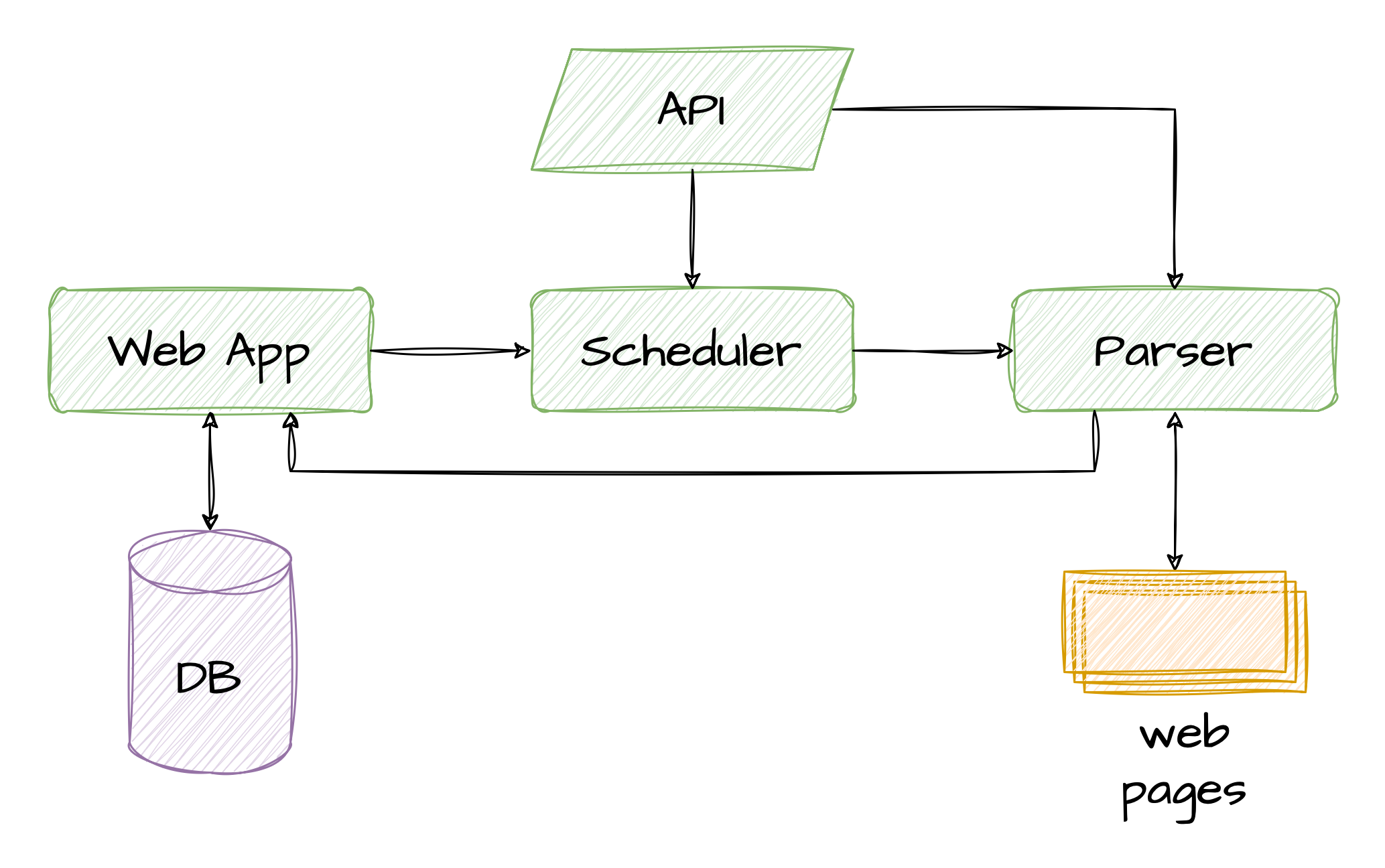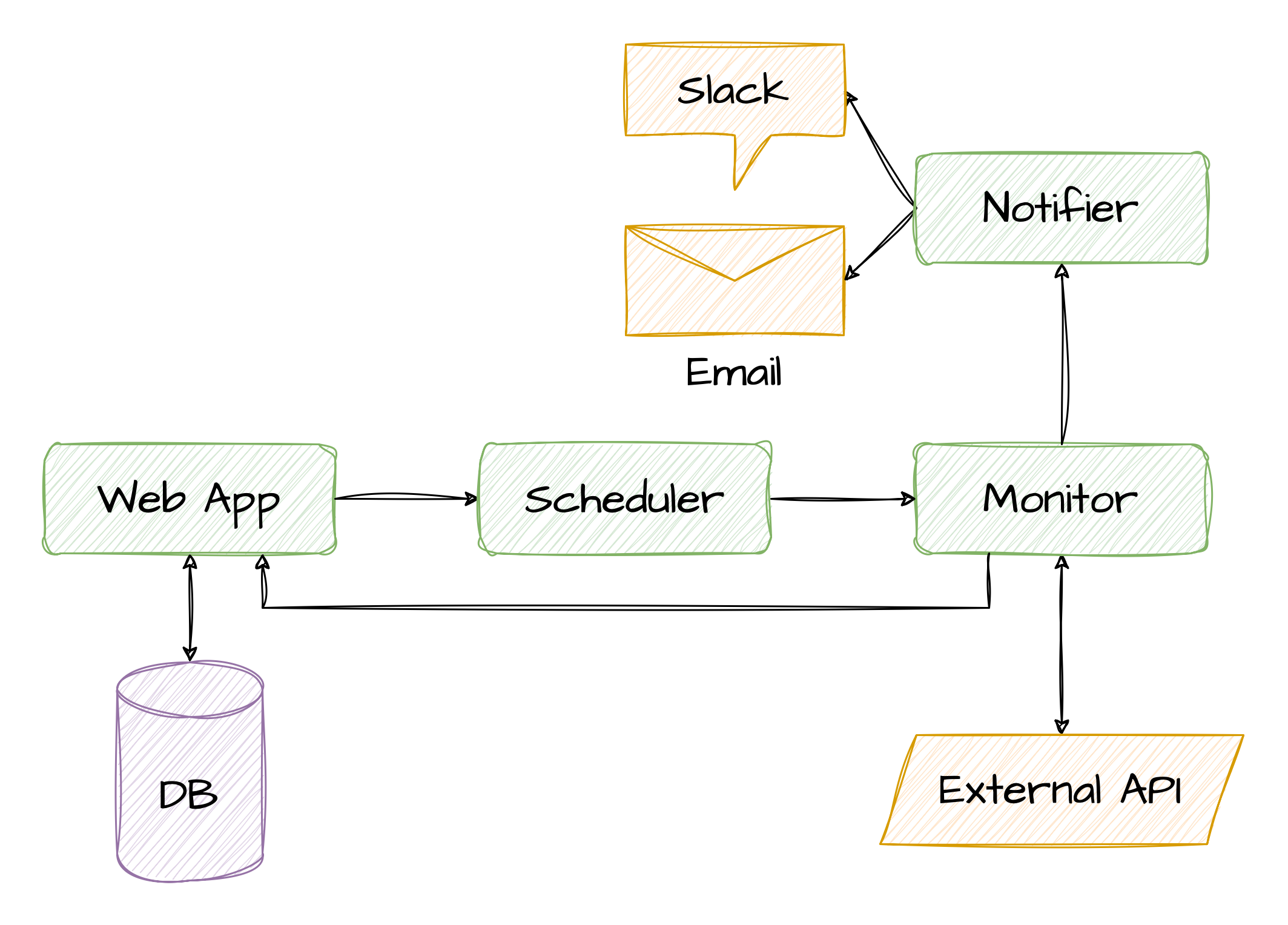Build, Learn, Monetize: 5 Python Projects and Micro SaaS Ideas for 2025

on [Unsplash](https://unsplash.com/photos/cosmic-view-during-night-time-TV2gg2kZD1o?utm_content=creditCopyText)](/assets/images/unsplash/spacex-TV2gg2kZD1o-unsplash.jpg)
2025 is rolling around the corner and it is time again to make plans for the new year. Software developer hobbyists and solopreneurs alike can get inspiration from my list of five software hobby project ideas and potential micro SaaS ventures.
I will describe these project ideas:
- Personal Emailer/Newsletter Service
- Mini-CRM for Freelancers
- Web Scraping as a Service
- Uptime Monitoring Tool
- URL Shortener with Analytics
Let’s get started!
1. Personal Emailer/Newsletter Service
The first idea is a service for sending personalized emails.
These emails can be “personalized daily summaries” or “habit-building reminders”. The service is actually the gateway through which another service can send those emails with the corresponding content. Besides the API, the service offers a simple UI to create and send those emails.
A battle-tested web framework like Django is more than enough for implementing a web app capable of these features. Django follows the MVT-pattern (model, views and templates) to serve websites to the user. The framework can easily learn to implement websites quickly.
The emails can either be sent directly or scheduled for later dispatch. For scheduling, there is a Python library called schedule to call a function at specific times. This can be used to send a daily summary, for example.
import schedule
import time
def send_daily_summary():
# ...
schedule.every().day.at("10:00").do(send_daily_summary)
while True:
schedule.run_pending()
time.sleep(1)
So how do you send an email using Python code? There are two possibilities:
- Sending via SMTP: This needs a server name, username and password to send the email. The Python library
smtpliboffers uncomplicated interaction with an SMTP server. In this case a dedicated SMTP server is needed, or each user can enter custom access details for an external server (BYOS = bring your own server). - Sending via a web service: Services like SendGrid API offer an API to send emails. For even more convenience, it comes with its own Python SDK! This gets sending an email via SendGrid API done in a few lines of code.
import sendgrid
from sendgrid.helpers.mail import Mail, Email, To, Content
sg = sendgrid.SendGridAPIClient(api_key='SENDGRID_API_KEY')
from_email = Email("test@example.com")
to_email = To("test@example.com")
subject = "Daily Summary"
content = Content("text/plain", "This is your daily summary:\n")
mail = Mail(from_email, to_email, subject, content)
response = sg.client.mail.send.post(request_body=mail.get())
These values and configurations need to be stored.
A simple database is enough for this purpose, for example PostgreSQL. If a SaaS-first approach is preferred, a service like MongoDB’s Atlas might do the job. It is slightly over-engineered for a simple email-service, but the deployment of a database can be difficult. This is basically the exchange of money for convenience and peace of mind.
Putting these parts together leads to a high-level architecture similar to this:

After implementing a working minimal viable product (MVP), this can be turned into a micro-SaaS.
Monetization can be done via subscriptions. These subscriptions can have pricing tiers that differ through email volume limits and additional features, for example advanced analytics.
A suitable hosting solution to deploy this SaaS can be found on this list: Top 9 Django Compatible Hosting Services + Deploying Steps. Do not forget to price the service according to indirect SaaS costs that incur, for example from the SendGrid API or MongoDB Atlas service.
These are the basic steps for a mailer web service.
2. Mini-CRM for Freelancers
Freelancers have to keep track of their customers.
A customer relationship management (CRM) system keeps track of customers and corresponding contact data, invoices, deadlines, etc. But unlike bloated CRM tools, this CRM focuses on simplicity, ensuring it meets the needs of freelancers without overwhelming them with feature-creep.
The CRM should focus on a specific target audience:
- For designers this system could include project-based tracking, requirement specifications, asset delivery reminders, and revision notes.
- For writers the CRM could provide an editorial calendar, content types per project (for example articles or scripts) or a submission tracker.
Basic functionality of the CRM system includes:
- User Management: Simple UI to add, edit, and delete client records.
- Invoice Tracking: Basic invoice creation and status.
- Deadline Tracking: List and reminders for project deadlines.
- Database: Storage for user data and configurations.
- Export Functionality: Ability to export client or invoice data.
- Authentication: Basic user accounts and login system for security.

Is this viable for a micro SaaS?
Yes, if it fills a specific niche. For example, the tool could focus on specific industries like designers or tutors. A subscription-based model would fit this style of SaaS: charge for volume of tracked clients and additional features like analytics or integrations.
3. Web Scraping as a Service
The web is full of data – it’s just not so easy to process.
This is where web scraping comes in. Web scraping is “used for extracting data from websites.” Imagine a website that shows soccer results: you want to store the results in a database to analyze them later. These results are probably embedded in tables and other HTML- and CSS-spaghetti, needing a robust, repeatable process to extract the raw data daily.
Python provides libraries like BeautifulSoup or Scrapy that help with parsing HTML code. The following well known book Automate the Boring Stuff with Python has a full chapter on this technique. Basic HTML knowledge is required to parse through a website’s markup efficiently.
A few simple lines of code to retrieve all links from a website looks like this:
import requests
from bs4 import BeautifulSoup
response = requests.get('https://www.wikipedia.org')
soup = BeautifulSoup(response.text, 'html.parser')
for link in soup.find_all('a'):
print(link.get('href'))
The web scraping service offers an easy API to scrape a website:
- Provide the URL of the website to parse
- Set the HTML path(s) to the data to extract
- Use basic
jinja2templating language to define the input and output format - (Optionally) Pick a schedule for automatic and periodic parsing with callback API
The response from the service should include any error handling when the parsing fails. If everything works, the raw, parsed data is returned.
Any schedules and configurations for parsing should be stored in a database. The actual parsed data should not flow into the database to prevent overflow.
For a frontend it makes sense to use a web framework like Django and scheduling can be done via the schedule package. Make sure to store the schedules in the database to persist the configuration over restarts.
The final setup could look like this:

How can you turn this into a viable micro-SaaS?
The service could offer a pay-as-you-go model, charging per scrape and any incurring data ingest fees. Additional features could also include:
- Pre-packaged configurations for websites, for example sports stats or currency rates (be aware of any copyright issues before selling foreign data on your website–when in doubt, contact the websites’ owners and negotiate a deal that might include a cut on your revenue for them)
- Storage for the scraped data, for example on a flat S3-storage
Good luck with this web scraper service!
4. Uptime Monitoring Tool
Services fail silently.
To avoid being in the dark about your service’s health, it’s essential to keep an eye on those. Solutions for monitoring services range from expensive monitor suites and log services to self-written frameworks. A simple service for indie hackers and micro-SaaS developers could provide just enough functionality to quickly set up effective monitoring.
This tool could offer these features:
- Scheduling: Set a schedule to regular ping the service for responsiveness
- Configuration: Provide HTTP method (GET, POST, etc.), request body, and headers
- Notifications: Allow emails or Slack messages to be sent on failure
- Callbacks: Offer a REST API callback to be sent to another customizable endpoint
Use the simple requests package from Python to ping a service, for example:
import requests
response = requests.get('http://colormind.io/list/')
if response.status_code is not 200:
notify(response)
Sending a message via Slack can be done via the Slack API and their Python SDK. There are a lot of good tutorials available, including Slack’s own documentation. The API needs OAuth, but for this example it is left out to keep it short:
from slack_sdk import errors, WebClient
client = WebClient(token="SLACK_TOKEN")
channel_id = "ABCDEFGHIJKLM"
try:
result = client.chat_postMessage(
channel=channel_id,
text="Service Failure!"
)
# ...
except errors.SlackApiError as e:
# handle error ...
The first example (the newsletter service) showed how to send an email in Python. Basic administration and configuration can be done similar to the other examples using a web framework like Django and a database. Including these components, the service could consist of the following parts:

So how can this make money?
Developing this into a micro-SaaS can be done by offering a subscription-based or pay-as-you-go model. In the subscription-based model, the user gets a limit of website-pings and monitored services per month and the pay-as-you-go model charges per ping. Additional features can be analytics and dashboards, additional notification channels like SMS, Discord or even automatic ticket-scheduling via Jira.
Have fun developing the monitoring service—even if just for your own services.
5. URL Shortener with Analytics
Sometimes some URLs are somehow too long.
That is why URL shorteners exist. They take an existing URL and provide a shortened version, which redirects any user to the original URL. These shortened versions are URLs from a URL shortener service with a randomized id, for example https://bit.ly/3Bg19uM, which redirects the user to https://eu.usatoday.com/story/travel/2022/02/10/amtrak-deal-valentines-offer-sale/6741296001/.
The Python framework Flask makes it easy to shorten and redirect.
Start by importing the Flask library components. Import uuid for shortening the URLs. Create the Flask app instance. Initialize a mapping to store every redirection.
from flask import Flask, request, redirect
import uuid
app = Flask(__name__)
url_mapping = {}
Provide an endpoint to create shortened URLs. Every shortened URL will be stored. Be aware that this is a simplified method for shortening: it does not check for collisions, for example.
@app.route('/shorten', methods=['POST'])
def shorten():
original_url = request.json['url']
short_id = str(uuid.uuid4())[:6]
url_mapping[short_id] = original_url
return {"short_url": f"http://localhost:5000/{short_id}"}
The most important endpoint is the actual redirection of shortened URLs. Look up the id in the mapping and redirect if found. Send a 404 if nothing was found.
@app.route('/<short_id>')
def redirect_url(short_id):
if short_id in url_mapping:
return redirect(url_mapping[short_id])
return "URL not found", 404
And start the app (in debug mode while developing).
if __name__ == '__main__':
app.run(debug=True)
Is this everything?
No, there is a need to persist the mapping over restarts: a database. Also: a user interface to let users configure shortened URLs with Flask and simple HTML pages with CSS.
The overall composition is still quite simple:

Can this make money?
Yes, by offering premium features to subscribers:
- Branded URLs for businesses
- Dashboards for analytics
- Customization for advanced redirecting
- QR-code generation for stickers
Be cautious when offering a freemium model: heavy internet traffic can quickly become expensive, as it is difficult to predict how many requests you will be redirecting. Make sure to factor in your own service provider’s cost in your pricing.
There are already a lot of URL shortener services on the market. Find your niche and a unique selling point by comparing the alternatives. Pick a specific target audience and tailor your service directly for them.
Conclusion
Every built project is another learning experience.
As a software developer, gaining new knowledge is important to stay up-to-date. This list of project ideas is here to inspire your next adventure and provide an opportunity to try something new.
Each project has the potential to be developed into a micro SaaS for monetization. Even as simple hobby or open-sourced projects on GitHub, they are worth building and learning from.
Some projects become successful and popular, while others remain on your disk infinitely. And that is okay, too. In the end, it is better than doing nothing and staying where you are.
Keep on coding and keep on creating!
